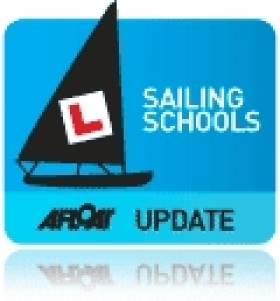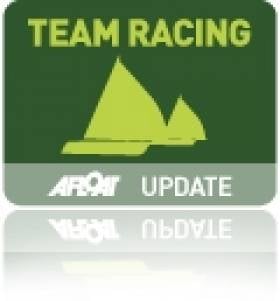Displaying items by tag: Royal St George Yacht Club
#yachtclubs – A new Dun Laoghaire-based political party, People United in Republican Endeavour (PURE), has launched its campaign for the forthcoming Local Government Elections with demands for changes in the style and names of the leading yacht clubs, both in Dun Laoghaire and throughout Ireland reports W M Nixon.
Introducing a Policy Document on behalf of PURE, the new party's spokesman Mr Hugh Mannity stated: "It makes me suffer to see these unfortunate people, the members of the Dun Laoghaire waterfront yacht clubs, being forced into aping the airs and graces of their former colonial oppressors".
"Despite the imminence of a State Visit to the Queen of England by the President of Ireland, we who are PURE demand that all vestiges of former royal dominance and patronage be removed entirely from every organisation, building and boat in Ireland".
However, Mr Mannity insisted that the changeover would be effected with a minimum of expense. "We know that perhaps the most costly aspect of this fresh new initiative will be in the changing of signs, letterheads and so forth," he said. "In the case of yachts, there would be additional expense in changing the lettering on the hulls denoting the club to which the owner belongs."
The Research Department in PURE has been burning the midnight oil, Mr Mannity claimed, in order to minimise expense, or indeed make it unnecessary altogether. "Thanks to our far-seeing think tank," he said, "the initials for the Royal Irish Yacht Club will stay exactly the same, only now it will be known as the Republic of Ireland Yacht Club".
"Equally, the Royal St George Yacht Club will retain its initials, but the title of the club will be changed to the Religious St George Yacht Club. This is because we in PURE find it doubly offensive that a leading yacht club should have a royal title combined with a political overtone which completely ignores the underlying theme of the sanctity of St George. So we hope to put the holiness back into the club for the good of its members"
"A problem arises with the Royal Alfred Yacht Club. We find it offensive that it should commemorate a now unknown son of the ruthless Queen Empress Victoria. Thus we have decided that, while it should retain its present initials, it should henceforth be known as the Real Alfie Yacht Club, named in honour of the much-loved long-term Lord Mayor of Dublin Alfie Byrne, who was also world-renowned for his pioneering work in moustache research and manipulation."
Mr Mannity continued by stating that his grouping would show its even-handedness by insisting on a change in the title of the National Yacht Club. "While we laud this fine club's lack of any royal associations in its name," he said, "we are concerned that these days too many organisations, in sailing as elsewhere, insist on having "National" in their title, thereby rendering it meaningless. Thus we will expect the NYC to become the TNYC – the True National Yacht Club. We appreciate that this will cause the members some expense, but our Field Researchers who regularly walk Dun Laoghaire's East Pier with their whippets tell us that, judging by the boats stored in the club's forecourt, the members could well afford to lay out the money on a 'T'."
When questioned about PURE's intentions regarding the Royal Cork Yacht Club, Mr Mannity said he did foresee a special problem. The Republic of Cork already existed within the Rebel County, and re-naming the club would be a matter of whether or not it became the Republic of Cork Yacht Club, or the Rebel County Yacht Club. "There could well be blood in the streets over that one" he admitted.
However, in order to show the depth of research undertaken by PURE's think tank on this entire matter, Mr Mannity pointed outthat not many people were aware that within the Royal Cork YC's present structure, the old Royal Munster Yacht Club still existed, and was recognised by the role of Commodore in the RCYC officer board, along with the Admiral.
"We feel that too many problems would be created by trying to establish a Republic of Munster in order to facilitate the existence of a Republic of Munster Yacht Club. Thus we have decided it should be re-titled the Province of Munster Yacht Club. We realise that this will necessitate a small change in the initial letter. But where some traditionalists still have RMYC across the sterns of their boat, we would point out that changing it to PMYC would only involve painting out one little leg of the letter 'R'. However, to show our goodwill, a small phial of white paint will be provided to owners to facilitate the change. We realise that this will only work with white boats. But the Irish taxpayer cannot be expected to fork out hard-earned cash for the awkward minority who insist on parading about on the ocean in boats coloured Mediterranean Blue or Sunset Red or whatever, when any civilised person knows that all proper yachts are white".
In concluding his PURE statement, Mr Mannity admitted that the root of the problem in creating a Republic of Munster lay in the continuing existence of the Kingdom of Kerry. "We're not crazy" he asserted. "We know that trying to subsume Kerry into a new Republic in a combination with Cork would be a step too far".
"Nevertheless we feel strongly that it is time and more for the good people of Kerry to reconsider their claims to the status of being a monarchy. Thus we propose what we feel will be a real vote getter. We plan to re-position Kerry as a Duchy. And plans are well advanced to request a noted KiIgarvan family to become the hereditary Dukes of Kerry. We feel sure that this brilliant innovative idea will be a surefire runner"
Royal St.George Preparing for 'Record' Optimist Euro Champs
#opti – With just under four months left to the opening ceremony of the Optimist European Championships, the Royal Saint George Yacht Club in Dun Laoghaire is preparing itself for a record entry.
To date 43 countries have entered teams totalling 245 competitors and 80 coaches and team leaders.
In addition to the 32 European teams, we are delighted to be welcoming 11 international teams as far afield as Antigua, Australia, Bermuda, Brazil, Canada, Hong Kong, India, Japan, New Zealand, Singapore, and USA.
Sail Cork Sailing School Celebrates Forty Years in Business at Royal Cork Yacht Club Gala
#sailcork – On Saturday night last the Royal Cork Yacht Club was buzzing for a delightful evening of chat, fun, meeting old friends and generally having a great time writes Claire Bateman. The night also marked the official handing over of certificates to all who had successfully completed their navigation or yacht master courses which are conducted by Sailcork at the club throughout the year and Eddie and Jo English took this occasion to celebrate Sailcork's fortieth anniversary with a magnificent dinner held in Royal Cork's newly named dining room 'The Globe Restaurant'. Special guests included Royal Cork Admiral, Pat Lyons and the Admiral's Lady, Ann. From Dublin came the Commodore of the Royal St.George Yacht Club, Commodore Liam O'Rourke and joining these special guests were Commodore Adrian Tyler from Cove Sailing Club and his delightful wife Teresa.
Following the meal and with everybody in the mood to enjoy Eddie's special presentation of a digital slide show all present settled down to be treated to a history not only of Sailcork and its forerunner, The International Sailing Centre, but he also took the captivated audience right back to Cork Harbour's history of sailing from the year 1664. There were many cheers and guffaws from members of the audience who recognized themselves on the screen in photographs from many years back. Commodore O'Rourke gave a very entertaining talk on his long association with Eddie and entertained the audience greatly with tales of their exploits over the years in the Caribbean.
The very successful evening was brought to a close with a hilarious presentation by Captain Anthony Mulcahy, Port of Cork Harbour Pilot, giving a picture, no doubt highly embellished, of what it was like to work with Eddie over the years and this drew howls of laughter from the audience. Anthony 's current role with Sailcork is providing tuition in VHF communications. He certainly had no difficulty in communicating with his very receptive audience last night.
All in all a great evening was enjoyed by everyone present.
The school recently won a sailing award in Afloat's inaugural Maritime Web Awards in December.
Bob Fisher, leading sailing writer and the supreme authority on the America's Cup, brought an inspiring vision of the highest peaks of the sport to the Royal St George YC's 175th Anniversary Champions Celebration last weekend. W M Nixon delves into the backstory of one of global sailing's true greats.
#americascup – There's a dilemma underlying the remarkable career of Bob Fisher. He is one of the best sailing writers in the world. He is probably the very best writer about yacht racing in the world. And he is the undisputed global authority on everything to do with the America's Cup – its history since the first race in 1851, its litany of extraordinary characters with their many wrangles, its technical advances, and its remarkable and sudden ultimate rise to become an event of truly global status during the 34th Series in September 2013 in San Francisco.
The dilemma? Well, The Fish is a true sailing polymath. For sure, he writes vividly about our sport. Yet he is also a talented racing dinghy builder – his own-built boats have won championships to international level. But he is also an extremely good sailor himself. Thus in his long career of writing about sailing, he has probably been a better natural racing sailor than about 98% of the people whose sailing achievement he happens to write about.
All of which explains his "absorbing interest" in the America's Cup, and his ability to produce the defining stories about it. For it is only at the America's Cup that Bob Fisher is best deployed as the reporter, commentator and historian while others do the sailing.
At other events during his long and varied career - he is now 77 - he has often been an active and successful participant in addition to being the man who files the stories at the end of the day's racing. And with this frequent personal involvement in the racing afloat and the apres sailing ashore, sailors see him as one of their own rather than a media person of whom they should be wary. Thus he can come up with the true inside stories which bring his words to life, raising them above reportage to become the vivid defining narrative of sailing as it really is.
Quite how he manages to do it is beyond most folk's imagination. He is doing enough to provide about half a dozen people of more ordinary energy levels with full time careers. Yet although there must have been times when the pace verged on being too hectic to handle, when you meet him participating and reporting in sailing events, or at a special sailing social gathering like the 175th Anniversary Champions Party at the Royal St George YC, it is to find you are undoubtedly in the presence of a great man, but also a man who enjoys it all to the full, with wide and civilised interests in many aspects of human life.
The notion of the 175th Anniversary of the Champions of the George originally came from Johnny Ross Murphy, and when he got friends and fellow members like the master-delegator Brian Craig, plus Derek Jago and Paul Maguire on side, the thing just grew and grew until with a group chaired by Craig, with the efficient Ciara Dowling making sure the nuts and bolts were in place, they worked at a list of who was eligible to be there.
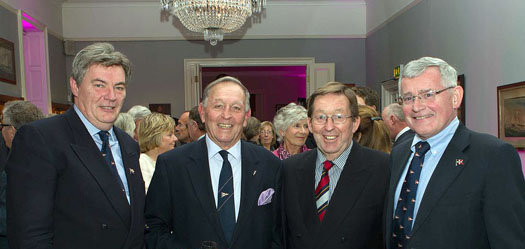
At the Royal St George YC 175th Anniversary Champions Night were (left to right) Don O'Dowd (Rear Commodore (Sailing) R StGYC), Bob Fisher, Winkie Nixon, and Commodore Liam O'Rourke. Photo: Gareth Craig
They managed to go back 62 years, and the final total was 597 major winners of one sort or another, from Dublin Bay champions right up to ten Olympic sailors. On the night, the target figure of 250 attendees had been long since surpassed, and with diligent research they had unearthed some top performers from a very long time ago. Yet it was also very much of today, for even as we reviewed the achievements of 175 years, we were also thinking of RStGYC member Adrian Lee already on his way to establishing the new course record with his Cookson 50 in the 360-mile mile Dubai to Muscat Race, which had started that morning – his success raised the RStGYC major achievement tally to 598 almost before the party was over. At the same time, fellow member Damian Foxall was in Le Havre awaiting the start of the Transat Jacques Vabre 2013 as co-skipper on the MOD 70 Musandam-Oman, but Foxall had to go through frustrating days of waiting as the raced wasn't to start until Thursday November 7th.
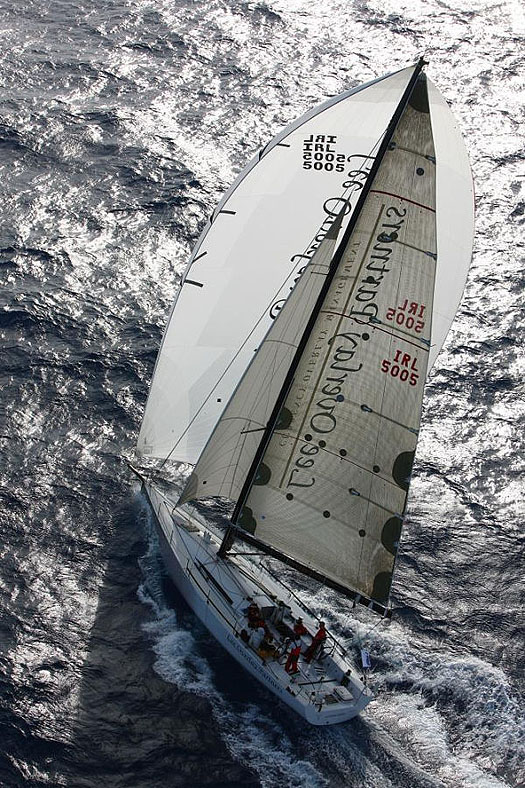
Even as the RStGYC 175th Anniversary Champions Party was under way, club member Adrian Lee was bringing the major achievements list up to 598 with his success in the Dubai-Muscat Race 2013 with his Cookson 50 Lee Overlay Partners. Boat and owner were already in the list with their overall win in the inaugural RORC Caribbean 600 Race in 2009. Photo: Tim Wright
It was quite a night in Dun Laoghaire, and with some crews reunited after more than three decades, there was a lot of catching-up to be done and news to be exchanged. So it says everything about Bob Fisher's ability to convey the new excitement of the current America's Cup that he was able to get the full attention of people in their sea of nostalgia, with his presentation provided an excellent spicing for an evening which would otherwise have been just too totally club-focused.
Sharing the round table at the inter-speeches supper with The Fish, we found topics covered were wide ranging and not necessarily entirely about boats and sailing. But nevertheless it is Bob's boat-owning history, and his uses of his boats, with which the ordinary sailing Joe can most readily identify.
The word is that just about all the Fisher myths are gloriously true. He did indeed absolutely have to sell his own-built championship-winning Fireball at a major event in Switzerland in the 1960s immediately after winning and before departing the hotel, as he and his crew had neither the money to pay the hotel bill (which was enormous, this was Switzerland after all), nor the funds to get themselves home.
He did indeed win his first race at his birthplace of Brightlingsea in Essex at the ripe old age of two years and three months (he was skipper, working mid-cockpit, while his father was detailed off to be the helmsman). And currently at his adopted home port of Lymington on the western Solent, he does indeed co-own with Barry Dunning the 1895-built 40ft Solent One Design Rosenn, the sole survivor of what was probably the world's first one design keelboat class.
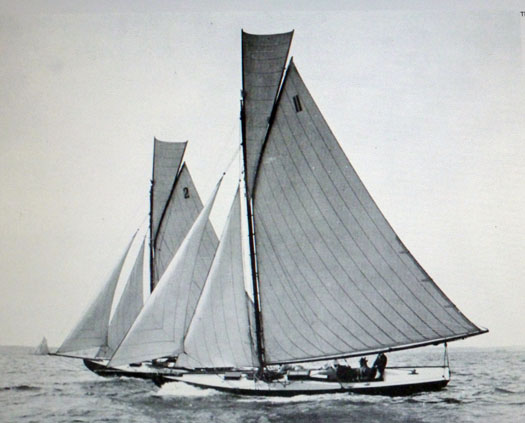
The Solent One Designs in their prime in 1895. They were probably the world's first proper one design keelboat.

The survivor – Rosenn (Bob Fisher and Barry Dunning) is the sacred relic of the Solent OD.
Thus it's likely that Bob and I were the only two members of the Old Gaffers Association at the 175th anniversary party in the George, as he now owns two gaffers, having given in to his crew's demand that while they can go along with gaff rig, sometimes they'd like to sail a newer boat. So he has obliged them by getting a boat three years younger than Rosenn, a lovely little Fife boat built 1898 which he has in Scotland in readiness for next year's 40th Anniversary Scottish Series, an event with which Bob has been closely associated since its inception.
It's the Scottish Series of 1992 which provides me with the most vivid image of Bob Fisher. Back in the 1980s, he was sailing consultant to the BBC soap Howard's Way, which was about the people – some good, some less so – running an expanding boatyard on the Hamble. To keep the series alive, the producers were looking for a new storyline which would take things in a believable direction, yet provide fresh excitement and business and technical problems with which a wider audience could identify.
Bob suggested that they should get the "yard" to start developing the building of a new-style Ultra Light Displacement Boat, a boat which would be big enough to provide accommodation of family cruising appeal, yet allied to a performance which would, in the ideal ULDB conditions, attract flat out racing types keen for sheer speed. The theory was that the human challenge in a project so far removed from the orthodox European boat type would create its own dynamic and drama.
He was given 48 hours to put the idea in a more concrete form. Now it so happened that some time earlier, he and Tony Castro had been doing a China Sea Race on a Castro-designed 40ft ketch, and though they could get her above ten knots on a good reach, hitting 11 seemed to be an insurmountable barrier. So in their frustration some very rough ideas were sketched out for a ULDB which would simply keep on increasing speed as the breeze built off the wind.
The rough drawings had been put away in a drawer and forgotten about, but after this script conference, Bob immediately phoned Tony Castro and asked him if he could find those drawings, and if so could he develop them up into a workable proposition for the day after tomorrow. More than a little midnight oil was burnt, but Castro came up with the goods, and the result was Barracuda, the 45ft prototype of the ULDB which in production went through various name changes, and was finally series built by Sadler Yachts as the Sadler Barracuda 45, with 19 being produced between 1985 and 1989.
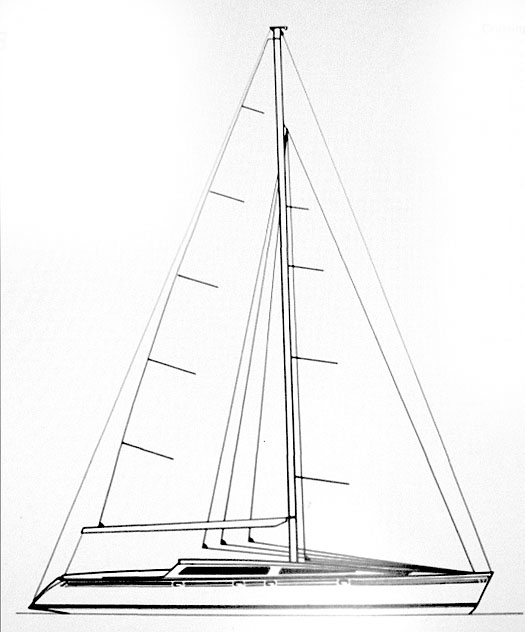
The above-water profile of the Sadler Barracuda 45 looked so normal it was a wolf in sheep's clothing, with the rig as shown only hinting at the fact that enormous masthead kites could be flown when conditions suited.

The hull profile gave a clearer indication of the boat's true character as a ULDB. The production boats had a hydraulically-raised keel, but Bob Fisher's prototype had a fairly straightforward heavily ballasted and very deep centreboard which was raised by a 3:1 tackle inside the centreboard case which was led to a winch on the cabintop. Two members of the crew were selected for the end-of-day centreboard-lifting grind with a double grip handle, and timed. The all-time record of 63 seconds was achieved by Bob and his exact contemporary Steve Lemon at Tarbert – "we wanted to get into the Islay Frigate asap"

The accommodation layout of the production Sadler Barracuda 45 suggests that the builders were unable to resist filling every corner, whereas a true ULDB will have minimalist accommodation, kept strictly admidships. Although few if any of the buyers of the 19 production boats went for the bath option, their boats all came out at least a ton heavier than Bob Fisher's own Barracuda of Tarrant.
They were a complex build project, with a hydraulically lifting bulb keel which in theory came up far enough for the boat to dry out level, tri-podded on her keel and twin rudders. And with so much space in the roomy hull around the keel housing, they even suggested fiilling an under-utilised gap on the starboard side with a miniature bath, but it's thought that few if any owners availed of this option.
But the timber-built prototype Barracuda of Tarrant herself certainly did the business in developing the storyline for Howard's Way, and she also provided Bob and his wife Dee with ten extraordinary and hugely enjoyable years of active ownership in which they covered tens of thousands of miles thanks in no small part to Dee's exceptional organisational abilities, and her willingness to ensure personally that the boat was at the desired venue and race-ready when Bob arrived in from covering some major sailing event elsewhere in the world.
It says much about the boat's versatility that in 1989 she proved ideal for the two-handed Round Britain and Ireland Race. Sailed by Bob with Robin Knox-Johnston, she scorched round the 2000 mile course to such good effect that she won her class without recourse to handicap, and finished ahead boat-for-boat of the boats in the next two classes above. It made for a change from a previous participation by Bob in this race, when he and Les Williams raced an 80-foot maxi whose sails were so heavy that in each stopover port, they'd to organise a farewell party so that guests could be spirited aboard the big boat in order to help with raising the mainsail.
But Barracuda by contrast provided the perfect combination of long-legged performance with manageable handling loads on both sheets and helm. Thus she frequently made the annual trek round Land's End and north to the Clyde for the Scottish series, and 1992 was a classic example. The main start for the feeder race to Tarbert was from Gourock, and I was crewing for my brother in his Belfast Lough-based Sigma 33. Back in 1992, the Sigma 33s were superbly fulfilling the Offshore One Design ideal, and heading south for Ailsa Craig on a beam reach in a brisk westerly, as the sun set we were streaking out past the Garrock Heads with at least 16 Sigma 33s in line abreast under spinnaker to leeward, and a dozen or so others in close attendance.
Offshore racing gets interesting when the sun sets, particularly so in one designs, for once the sun is gone, you're not allowed to luff. With 16 boats in line and competition intense in the Sigma 33s, there was more than a bit of mighty roaring (our skipper, my own brother, amazed me with his invective towards the boat next to us), leading in turn to shouted debates above the roar of the bow-waves as to how you define sunset on sailing water surrounded by mountains.
But then a great silver wraith came sweeping past as though the Sigma 33s were standing still, and all were briefly silent in admiration. It was Barracuda. Having started quite some time after us, she was zooming south in conditions she loved under an unbelievably large masthead gennaker, with the other boats in her class – some quite substantially larger – left many miles astern.
It was a magic vision in the special light of a long Scottish evening of late Spring. And it was made even more remarkable in that it seemed as though The Fish was sailing her single-handed. For there he was, unmistakable at the helm, his wonderboat perfectly under control with her twin rudders and sails beautifully trimmed, yet set up in such a way that the crew could retreat below for a mug of something hot as the cold Scottish night set in.
Bob and Dee's crews on Barracuda always seemed to be recruited from central casting to have strong characters to match their skipper. So it was entirely in keeping with the boat's style to imagine that they should have decided the skipper could be left on his own to steer the boat to match the setup of sails which briefly had the sheets made fast.
And in Barracuda's rapid passing, it left us the abiding image of Bob Fisher, stately at the wheel, monarch of all he surveyed, happily guiding his beloved dreamship as she swept onwards into the gathering night, with the glorious prospect of yet another wonderful sailing season stretching into the months ahead.
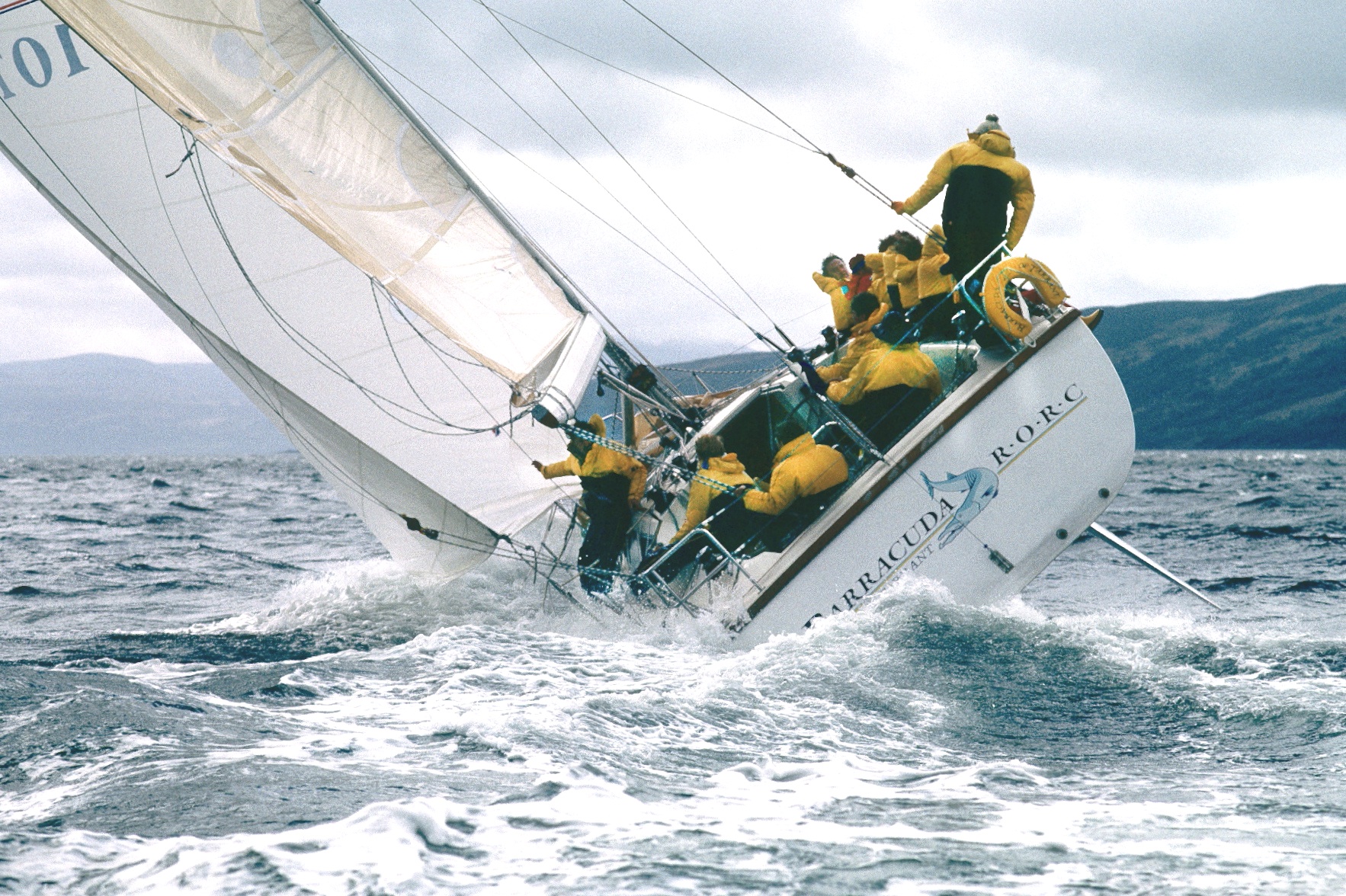
The mighty machine – Barracuda of Tarrant at the Scottish Series 1986. Twenty years before twin rudders became mainstream for large broad-sterned boats in Europe, Tony Castro incorporated them on Bob Fisher's new ULDB. In these squally conditions, a standard broad-sterned yacht of 1986 would have been spinning round to look at herself at frequent intervals. But with the skipper comfortably ensconced at the wheel under his famous black sou'wester, Barracuda tracks as though on rails, with her weather rudder completely clear of the water while her lee rudder is doing the business in a vertical position of maximum efficiency. This design of 29 years ago is still ahead of the game, and it's reckoned a boat built to the same lines and concept, but using the latest construction methods, would be one very potent machine today, Photo: www.patrickroach.com
RS200 Demo Day At The Royal St George Next Week
#RS200 - The RS200 fleet is running a demo day at the Royal St George Yacht Club in Dun Laoghaire at 2pm on Saturday 2 November. All are welcome and slots can be booked by emailing Heather at [email protected].
There will be five or six boats on the water on the day, with one onshore to look over and a little windward/leeward course afloat to put the boats through their paces.
The RS200 fleet is mainly located in Leinster so far, with 22 boats in Greystones, seven at the Royal St George and a few more dotted around the country. Up north there are boats in Newcastle, Ballyholme, East Down, Royal North and Cushendall.
There were 20 boats at the 2013 Nationals and new boats have been bought since. Regattas are highly sociable affairs with events shared with sibling classes the RS Feva and the RS400.
The RS200 has a number of points in its favour:
- High performance asymmetric non-trapeze double hander
- Great build quality and value: excellent second-hand boats from €2,500, and even 10-year-old boats have won Irish Nationals
- Wide weight range from 110-160kg, manageable for all ages and standards - hence a big family involvement
- Hugely popular in the UK, with a 100-plus-boat National Championships, and is also big in Scandinavia, US and Australia, so no resale risk
- Attractive overseas events for serious Irish racers: 2014 calendar includes Carnac (Brittany), Lake Garda and Hayling Island in the UK
Do come along for a sail or even just a chat and a gander at the display boat. There will be a similar demo on the northside of Dublin soon (venue and date to be decided) so that may suit some people later.
And if you're attending the ISA Dinghy & One Design Convention at the National Yacht Club that morning, it’s just 100 metres to the Royal St George!
Lyttle Triumphs in RStGYC Sail/Cycle Event
#rstgyc – The 3rd Cycle Superstore sponsored Sail/Cycle Challenge was held in the Royal St George Yacht Club last weekend in glorious weather conditions. The unique event comprises of a 60 km cycle over the Wicklow mountains with three time trials and three Laser races.
35 cyclists lined up in the club for the start of the cycle. The route took them over the Vico road towards Enniskerry village. Competitors were using the cycling app Strava to automatically log their individual times on each time trial segment. It was clear from the start that Neil O'Toole was fast and when the results came in, he had won the first leg by over a minute! O'Toole went on to win the next two time trials, followed closely by Gordon Judge and Helena Barrett. The route took cyclists up to the top of Glenncree and onwards over the Featherbeds, a total altitude gain of over 1000 metres.
On Sunday morning three Laser races were scheduled by PRO Frank O'Beirne. The format required that the races were a maximum of 30 minutes in length, so in less than 3 hours, three great races were sailed in sunny 10-15 knot conditions. Race one saw Sean Craig steal an early victory followed by Paul Keane and Theo Lyttle. Race 2 saw a complete change with Ross O'Leary leading from start to finish. Neil O'Toole, the clear favourite going into the sailing leg of the challenge, was placed 6th and a 7th throwing the competition wide open.
Going into the final race Craig, Keane, O'Leary and Lyttle were neck and neck for the sailing part of the competition and overall O'Toole and Lyttle had to battle it out for the trophy in the last race. Craig once again led around the windward mark only to be overtaken by Keane and Lyttle on the first run.
As the wind died down Lyttle squeezed ahead of Keane to win the Cycle Superstore Sail Cycle Challenge 2013.
Cycling Results
1. Neil O'Toole
2. Gordon Judge
3. Helena Barrett
4. Francis Barry
5. Theo Lyttle
6. Chris Arrowsmith
Sailing results
1. Theo Lyttle
2. Sean Craig
3. Paul Keane
4. Ross O'Leary
5. Dan O'Connell
6. Chris Arrowsmith
7. Neil O'Toole
8. Will Nesbitt
9. David Dwyer
10. Frank Heath
11. Richard Tate
12. Alain Deladienne
13. Pat O'Brien
14 Francis Barry
15 176280
16 John O'Keefe
Overall Winners
1. Theo Lyttle 11 points
2. Neil O'Toole 13 points
3. Chris Arrowsmith 23 Points
4. Frank Heath 32 points
5 Francis Barry 33 points
6 Richard Tate 35 points
Dublin Bay Sailing on Target for a Summer Sizzler
#vdlr – The waterfront in Dun Laoghaire wears its history lightly. In observing it, you're immediately aware of the elegant pavilions which are the classically-designed premises of the three senior yacht clubs, places which are redolent of a long history. But because there is so much in the way of boats and sailing sharing the space with them, and bringing the harbour waters so brightly to life, these are not brooding edifices setting a sombre mood on all about them.
On the contrary, they're fun places, brimming with vitality. They speak of living in the present, even as they acknowledge their interesting past. And as their history has been intertwined with the history of Ireland for almost two centuries, perhaps it would be useful for the rest of the country to realise just how skillfully Dun Laoghaire's yacht clubs have steered themselves through times good and bad. For they've come through national changes which, you might think, would have swept away the clubs and much of what they represented. Yet now they are happily accepted as an integral part of the community, playing a key role in the life of one of Ireland's most vibrant regions, and functioning at a sporting level which gives them national and international significance.
With all four clubs combining in the four day Volvo Dun Laoghaire which starts next Thursday with summer settling in nicely in time on Dublin Bay, the importance of their shared role comes centre stage. But this past week, we highlighted the achievement of one club in particular, when the Mitsubishi Motors/ISA Sailing Club of the Year trophy was formally presented to the Royal St George Yacht Club on Wednesday evening.
Though its title is Club of the Year 2013, it's awarded for success in 2012, and it was first announced in March. However, clubs have their private side and their public side, and the presentation of the ship's wheel trophy (which has been part of the sailing scene since 1979) in the club's own premises makes the award complete, as it's an opportunity to celebrate the contribution made by all members to a club's success.
In fact, in the case of the George, it was people from all over Ireland who contributed to the success, as they volunteered to help with the main feature of the 2012 season, which was the Royal St George YC's position as the lead club in organizing the ISAF Youth Worlds in Dun Laoghaire in July. It was a massive effort, happily crowned with success and international praise. It was led by a formidable team in which Brian Craig managed to be a hands-on Chairman yet with a formidable talent for skillful delegation, so much so that on Wednesday night it was suggested he should write the definitive Delegation Manual. He shouldn't find the actual writing too onerous, as he could delegate that too.
But we could be sure he would do it in precisely the right way, for the thing that really impressed the adjudicators was the thoughtful way in which the George's ISAF team went out of their way afterwards to thank their many voluntary helpers, and to make sure they knew their efforts were truly appreciated. The club set a benchmark in organisational good manners which could be usefully emulated in every walk of Irish life.
However, there's much more to running a successful club than simply hosting events. The adjudicators look to sailing success by members as well, and in 2012 for the Royal St George it was Commodore Martin Byrne who set the pace – in his first year he had won the Edinburgh Cup in the International Dragons (first won by a George member with Jimmy Mooney in 1953), and in 2012 he was top skipper in the entire Irish Dragon class.
As for encouraging youthful talent, the George is almost notorious for its skill in recruiting the new sailors who come to Dublin from all parts of the country. The club goes out of its way to encourage university racing, and when UCD won the Irish title in March, and with it the right to represent Ireland in the Student Yachting Worlds in France in October, it was members of the George who pulled out all the stops to ensure that the UCDSC squad had the necessary boats and facilities to train for this major international event in which they were runaway winners.
And yet all this was happening under the umbrella of a club which can trace its history back to 1838. When the 900 delegates arrived in Dun Laoghaire for the International Sailing Federation's Annual Conference in November, those who had heard of the success of the ISAF Youth Worlds, but hadn't previously been to the venue, were surprised to find that at the heart of it is a stately clubhouse and an organisation going back 174 years.

Le Grand Fromage. The Marquis of Conyngham was the Royal St George YC's first Commodore
The club's extraordinary history, and its intertwining with the national story, was equally surprising for the visitors to grasp. After all, here was an organisation successfully reaching out to young sailors from every corner of the globe. Yet it was doing so from a clubhouse which, once upon a time, had been the almost exclusive preserve of the arrogant offspring of Cromwellian land-grabbers.
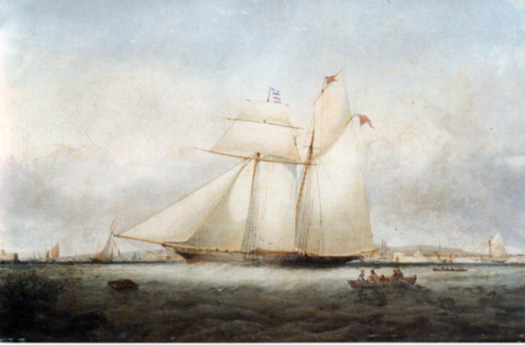
The Marquis of Conyngham's schooner Constance in the harbour, 1855.
Indeed, the membership was so extensively drawn from the wealthy land-owning classes that at one stage around the 1870s, the total tonnage of the large yachts owned by Royal St George YC membership rivalled those of the Royal Yacht Squadron itself. Yet further to complicate the story, the conference in the early 1900s which set in place the Land Commission which was to end the dominance of the Ascendancy landlord class was actually chaired by one of their own, Lord Dunraven, a member of the Royal St George YC since the mid 1880s.
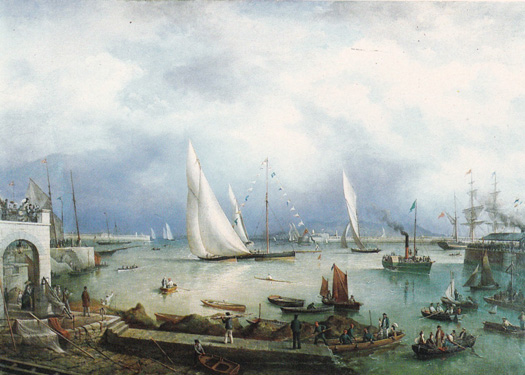
The rare ould times. Royal St George YC Regatta in 1871, when the tonnage of the club's fleet of yachts was exceeded only by the fleet of the Royal Yacht Squadron.
So it's a club which knows when to move on as much as it is aware of the need to acknowledge its rich and colourful history. Certainly it has moved on from membership dominance by a certain kind of yachtsman. The first Commodore was the Marquis of Conyngham, and he was succeeded by others of similar style. But these days, with a greatly expanded clubhouse and the most modern sailing facilities, the flag officers are more likely to acknlowledge descent from remote princes of Breffni, and wild chieftains of the ancient Wicklow hills.
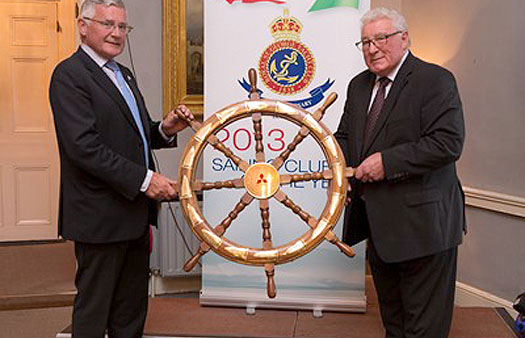
Sailing Club of the Year 2013. RStGYC Commodore Liam O'Rourke (left) receives the trophy from Frank Keane, Chairman of Mitsubishi Motors Ireland.
The names may have changed, but the sailing goes on more busily then ever, and the club is rightly making much of its 175th Anniversary this year. Commodore Liam O'Rourke is leading his members in a programme in which the Volvo Dun Laoghaire Regatta will be the season's highlight, and the George's own special contribution will be hosting the finish of the first stage of the Clyde Cruising Club's Blue Water Trophy Race, which started from Troon in Scotland last night, with the leaders expected in Dun Laoghaire tonight and tomorrow.
This will be bringing a significant contingent of Scottish boats south with many of them then lining up to take part in the VDLR, where the total entry at close of the list at midnight Thursday was 377 boats, including more than 120 visiting ones. Yet any overview of the entry list for this year's Regatta from Thursday 11th July to Sunday 14th July, suggests a new maturity, a sensible coming-of-age. Organisers and participants alike are accepting the social limitations imposed by the fact that most participants will be sailing from their home port. It's one very suburban seafest. And the reality of several years of global recession, biting harder in Ireland than most other places, means that the excitement of completely new boats making their spectacular debut will be conspicuous by its absence.
In looking at the lineup and considering the spirit of the event generally, one word springs irresistibly to mind. This is an unpretentious regatta. Not in any derogatory sense, we hasten to add. It's just that times are tough, so it's simply a case of keeping the head own, and making the best of things. And once you've accepted that, then things aren't so bad after all. There are stacks of boats about, just waiting to be sailed. And though some top crews have left Ireland as economic emigrants (Australian sailing has become even noisier these past two years), there are still plenty of good sailors about. And thanks to the boom years, facilities are better than ever – so let's get out there, and use them.
The result is an entry list pushing towards 380 boats, with an interesting spread which sees the local fleets putting on their best show, while the intriguing array of visiting boats is drawn almost entirely from the Irish Sea/St George's Channel and the North Channel/Clyde areas, with some gallant supporters from the improving facilities in South Wales.
But if you're expecting significant numbers from Ireland's self-styled capital of sailing, good old Cork, well, as they'd say in Manhattan – fuggedaboudid. There's just former Helmsman's Champion of Ireland Stefan Hyde with his J/24 Nyah, and that seems to be it for the Rebel County. But thanks to the marvellous new road from Galway, they too have one representative, the appropriately-named Corby 25 Tribal (Liam Burke). Otherwise, the visitors come sailing from as far away as Coleraine and the Clyde to the north, and Swansea to the far southeast, plus virtually all ports in between.
Clyde sailors have a happy history of involvement with Dun Laoghaire regattas, and they are well-represented in the good turnouts in IRC 0 and IRC 1. It was the most telling indication that recession was upon us when the new First 40, successor to the great First 40.7, made her debut with first and second overall in the 2010 Sydney-Hobart Race. For not one has yet been seen in Irish ownership. But thanks to Clyde Cruising Club skipper Christine Murray, we'll have a chance to see her new First 40 Elf Too in action in Class 0 in Dublin Bay.
Lined up against her will be regular contender Richard Fildes from Abersoch with his Corby 37 Impetuous, and the Howth duo of Alan Chambers and Nobby Reilly with their Mills 36 Crazy Horse, while the home fleet has George Sisk's Farr 42 WOW leading the charge in a comprehensive turnout of a dozen IRC 0 boats.
With 18 boats, IRC 1 has a particularly good representation from the North Wales/Liverpool fleets. And like IRC 0, it has more visitors than locals, so Dublin Bay star Paul O'Higgins with his Corby 33 Rockabill V will be on his mettle to defend the honour of Leinster against visiting dominance.
IRC 2 will provide a sporty start with 25 entrants, 15 of them non-Dun Laoghaire boats. Top of the list is Dave Cullen's 30-footer King One from Howth, which was the Half Ton World Champion under the command of Paul Elvstrom a very long time ago. But there's life in the old King yet – last year she was top boat in Kent in Ramsgate Week, which has become a happy hunting ground for the Cullen crew. Another hot former Half Tonner is Nigel Biggs' Checkmate XV, which has strong North Wales and Cowes connections interwoven with her Dun Laoghaire/Royal St George YC links, while the Brian Cusack team from DLMYC are also into the vintage Half Ton scene with Dick Dastardly.
With 32 boats drawn from 19 different clubs, IRC 3 tops the variety stakes in every way, and includes such classics as the She 31B She Too from Abersoch and the Nich 31 Saki from Dun Laogahaire. Last season, Vincent Gaffney from Howth moved up a couple of feet by changing his successful 26ft Albin Express Alliance for Alliance II, a rare breed Laser 28 with which he has been getting in the frame, definitely a boat to watch, particularly if lighter airs dominate the regatta.
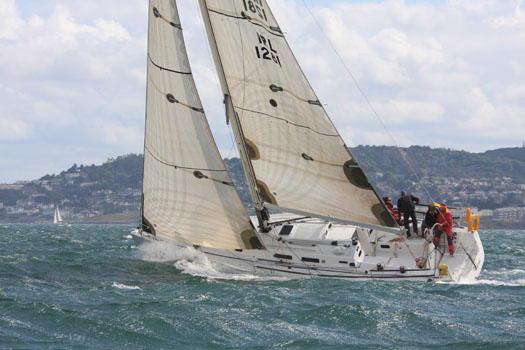
The J/109 has settled in very well as one of the VDLR's premier classes. Photo: Gareth Craig
Dublin Bay is of course the home of One Design racing. When the J/109 made her debut some years ago, sage observers reckoned that here was the perfect boat for a new Dublin Bay OD class. The J/109 has been there or thereabouts as an established class in the bay for a while now, and they certainly make their mark in ISORA racing. But a solid turnout of 14 boats from both sides of the Irish Sea for VLDR 2013 is just the vote of confidence these attractive boats deserve, and this will be one of the hottest fleets with current ISORA Champion Sgrech (Stephen Tudor, Pwllheli SC) very much the boat to beat.
With 16 boats, the growing strength of the First 31.7s is evidence of continuing enthusiasm for one design racing, and recognition of good value for money. Admittedly in the early days of the class, when boats were being bought in Celtic Tiger enthusiasm, the time spreads across the fleet spoke of wildly varying levels of expertise, but things have settled down and there's genuine competition, such that the numbers involved now exceed the longer-established Sigma 33s by three boats.
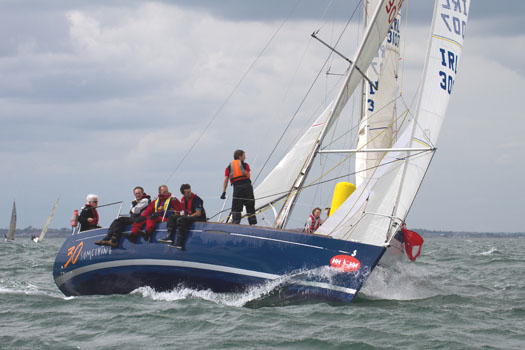
The fleet of First 31.7s now outnumbers the Sigma 33s. Photo: Gareth Craig
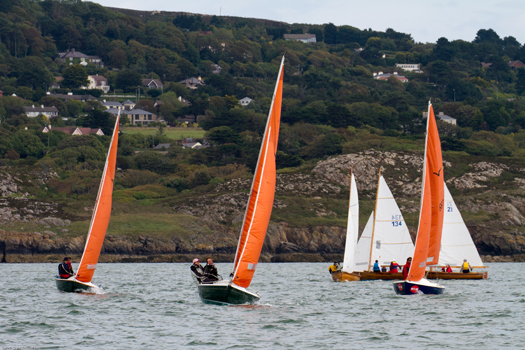
One design classes making the most of this opportunity of four days of intensive racing will include the Squibs and the Mermaids. Photo: Gareth Craig
Older production cruiser-racers sailing as one designs continue to have their adherents, and it's a special year for the Ruffian 23s as 2013 marks their 40th Anniversary, while the Limerick-built Shipman 28s – which should see their 40th in the next couple of years – can still attract a dozen adherents.
There'll be an element of a local derby about the racing for the eight boats in its SailFleet J/80 flotilla, as four will be raced by Northside crews, and four by Southside. We hear no word of any Eastside crew, which would be the pedantic definition of a team from Howth, but doubtless they'll be involved.
Some of the longer-established one design classes are only a shadow of their former selves, but they all have an ability to make come-backs in impressive style. Perhaps the Flying Fifteens are showing us how to do it. They've a solid entry of fifteen regularly raced boats – and every one of them sails from the National YC. The boost of having a single post-race social focus seems to be the secret of success here.
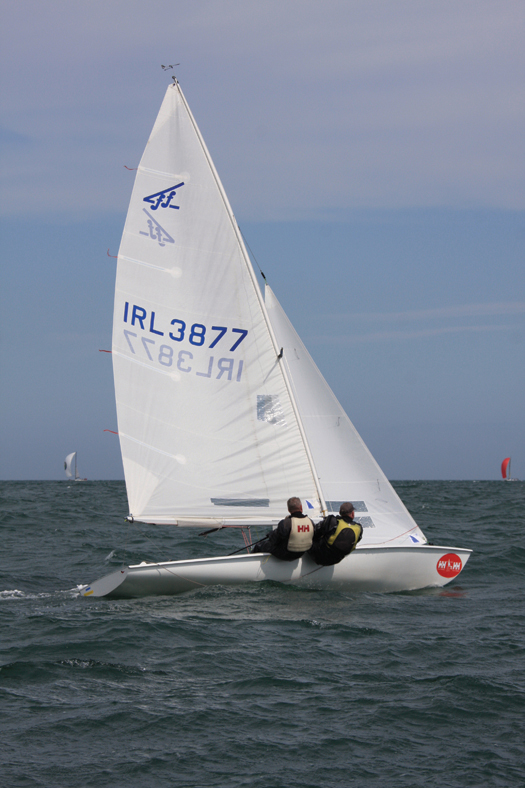
With all owners and crews concentrated in one club, the Flying Fifteens have been thriving as a local one design. Photo: David O'Brien

The classic IDRA 14s make the VDLR a feature of their season Photo: Gareth Craig
We end our preview of VLDR 2013 on an interesting note. A couple of weeks ago, we were enthusing in this blog about the "new Dublin Bay 21" – in other words, the Beneteau First 21 in its several variants, which will be racing as a class in VDLR for the first time this year. At the time, we did a quick trawl of boat sales notices, and found that you could expect to get a reasonable First 21 in the UK or France for between €14,000 and €17,000, which made for an interesting proposition for convenient ready-to-go one design racing in Dublin Bay.
But since then, a 1993 First 210 in Crosshaven has come on the market, advertised on Afloat.ie for €10,500. At that price, she can't be perfect. But heaven knows there's enough boat re-fitting talent around Crosser to get her up and ready to race in Dublin Bay next Thursday, thereby doubling the number of Cork boats racing in VDLR.
It's an interesting challenge. After all, when the new South Coast One Design Class suddenly started hitting the spot down in Cowes in 1956, Max Aitken became enthusiastic and challenged that very fine boatbuilder Clare Lallow, leading builder of the new boats, to build him one within a week. Lallow and his men did it in style. If they could do that from scratch with a timber 26 footer, surely the many talents of Crosshaven could make a slightly tired 21-footer race-ready in three days?
The Royal St. George Yacht Club in Dun Loaghaire, the 2013 winner of the Mitsubishi Club of the Year, hosted its principal annual event, the George's Day Dinner on Saturday, 27th April 2013. This year the celebration was all the more special for it marking the 175th year since the Club was founded.
To the delight of guests and Members, Honorary Member, Sir Robin Knox-Johnston, of Clipper Ventures Plc was the guest speaker on the night. Sir Robin kept everyone utterly enthralled with his stories of adventure on the high seas.
Speaking at the Royal St. George, Sir Robin said, "It is an honour to be here, in this Club so immersed in a rich and vibrant history to celebrate with you the momentous achievement of a 175th birthday. While the successes of the past are undoubtedly important, what impresses me most is how you are looking to the future with a determined vision to ensure the next 175 years and beyond as a presence on the Dun Laoghaire waterfront – the Club's efforts with local schools to instill the love of sailing in children, the Special Needs and Access Sailing programmes are all to be applauded in broadening the reach of this fantastic sport."
As part of the evenings proceeding at the George's Day Dinner, Commodore Liam O'Rourke awarded the Jameson Trophy, the Club's premier trophy which is presented for outstanding contribution; this year's recipient was Ken Williams who started working for the Club as a contractor overseeing the Forecourt development in the late eighties and has been an integral part of the Club's fabric for nearly twenty five years, he is much loved by both Members and staff. To the best of their knowledge, it is the first time in its history that the trophy has been awarded to a non-Club Member.
Guests of Commodore O'Rourke included the British Ambassador to Ireland, H.E Dominick Chilcott, Cdr Aedh McGinn Commanding Officer of the LE EMER and Flag Officers representing many sister clubs.
Visitors Win Royal Saint George YC Invitational Team Race Title
#teamracing – The Royal St George Yacht Club continues to develop as the centre of team racing in Ireland. The "George Invitational" sailed on 23rd – 24th March marked another important step – with the inauguration of a flight of brand new Firefly dinghies.
Nine teams competed this year for the Invitational trophy The top Irish teams were competing: - the National Champions the George Knights; the newly crowned University Champs, University of Limerick and double School Champions (both UK and Ireland) from Schull Community College. Two teams from the UK competed, 'Spinnaker' and, above all 'Wessex Exempt' the current Irish Open Champions, who had drafted in World Champion Andy Cornah into their line up making them the pre-event favourites.
The weather did not cooperate. Event organiser Marty O'Leary, acting as OOD, ably assisted by Nin O'Leary and Richard Bruton did well to complete two rounds of sailing on Saturday in a gusty 25 knot south-easterly.
Competitors raced in the home club fireflies, 6 of which were the brand new Orange and Blue boats. The multiple mark rounding in winds gusting up to 30 knots meant for plenty of thrills and spills. With some marks within feet of the the East Pier the passing Saturday strollers were entertained by some skilled and spectacular sailing.
After an initial mini round robin, the 5 top teams went through to the Gold Fleet with the bottom 4 sailing in the Silver. After this round Wessex Exempt led the Gold Fleet with 3 wins, breaking the tie break with their Southampton rivals Spinnaker who also had three race wins. The home club's team the RSGYC knights had 2 wins to lie third, defending champions Howth Yacht club lay fourth with one win and the college stars of UL were fifth.
Sailors and Umpires enjoyed a great dinner in the Royal St. George's formal dining room on Saturday night, with Marty O'Leary acting as compere for the evening and encouraging each team to perform a party piece.
Sunday morning brought more South Easterly breezes but with winds now gusting 35 knots and an air temperature of 4 degrees, competitors, race committee and umpires were keen to stay ashore. A second Gold Silver league had been started on Saturday evening with the Knights making the early running. But ultimately the weather had the final say and the results of the previous Gold/Silver rounds determined the trophy.
So the team of Wessex Exempt ; Jon Pinner, Sharon Quigley, Andy Cornah, Rachel Williamson, Claire Lasko and Bethan Carden ended up winners of the 2013 RSGYC Invitational.
For further information on team racing in the Royal St George contact John Sheehy: [email protected]
For information on team racing in general contact Gordon Davies, Hon Sec Irish Team Racing Association: [email protected] and telephone 0861501220
Link to the latest Irish Team Racing News
Kilkenny College Win Leinster School Sailing Championships
#teamracing – Eight Leinster schools gathered at the Royal St George Yacht Club on Sunday to battle for provincial bragging rights and coveted places at the Irish Nationals in Schull writes Heather King. The sailors raced in two six-boat flights of Firefly dinghies owned by the RStGYC, including one flight just out of the wrappers!
Under the stewardship of Organiser John Sheehy and Racing John Downey, the racing was slick and very competitive. Conditions were fairly light and tricky though, with the finish line just yards away from the changeover point halfway down the East Pier. Great spectating for competitors, parents and strollers.
After the twenty eight race round robin with each team racing seven times, a clear divide emerged with 4 teams ahead on 5 or 6 wins. Kilkenny College and Gonzaga both had six and St Andrews and Belvedere College were both on five. In the second half of the table Mount Anville emerged top on 3 wins with a young team that very nearly took one or two big scalps along the way. The other teams – Gonzaga B, St Gerards and a selection from Bray schools - all had their finer moments and consistently displayed great teamwork and camaraderie.
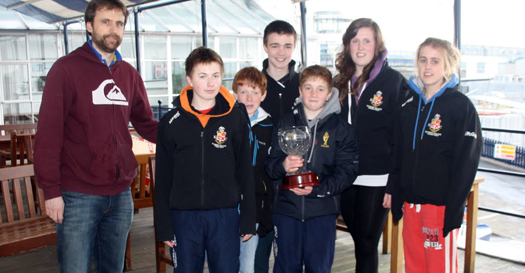
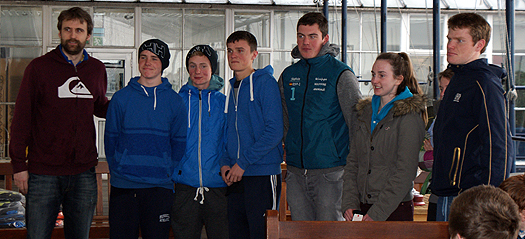
Royal St. George organiser John Sheehy (left) with (top) Kilkenny College winners and (below) the third placed St. Andrews College team
By 1600 hours the harbour had become a glassy pond and despite an effort to run another round, the RO called a halt. The big round robin series decided the results with tie-breaks going the way of "who beat who" in individual matches.
This gave the title to Kilkenny College and their team of Heather O Connor, Conor O'Reilly, Scott Levie, Sean Landers, Douglas Elmes and Emily McGrath, with Gonzaga 2nd and St Andrews 3rd and Belvedere College 4th. Mount Anville in 5th took 1st all-girl team. It is top 5 that are guaranteed places at the All-Irelands in Schull on April 13,14.





























